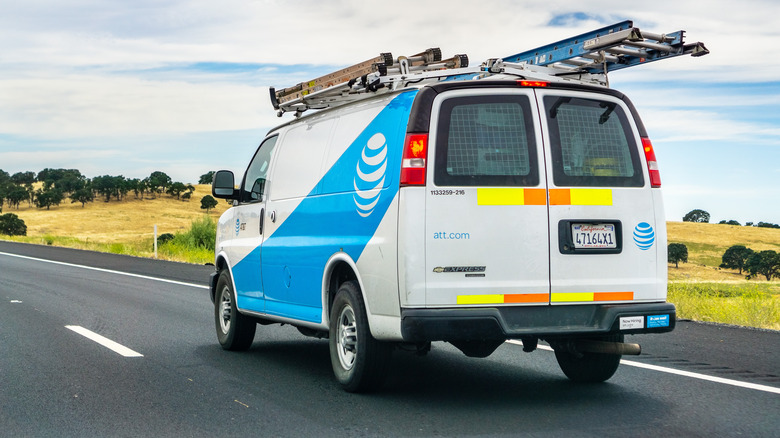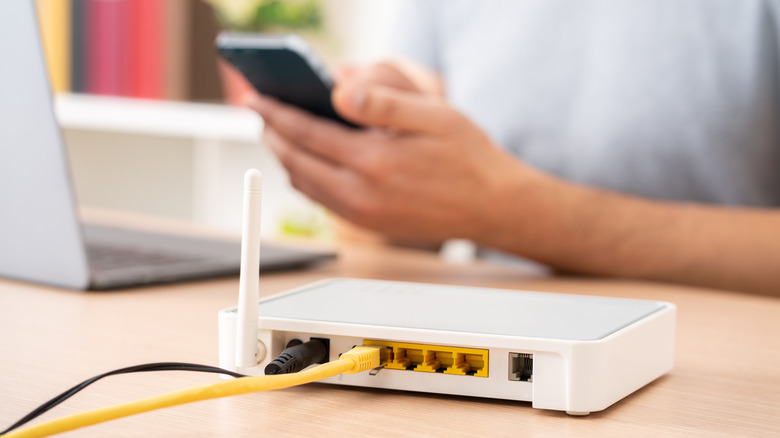The Biggest Pros And Cons Of AT&T Wireless Home Internet Service
Staying connected is one of many people's priorities in life, and you need a dependable internet connection to do so. AT&T is already one of the best major internet service providers in the U.S., and the company's wireless home internet service aims to keep people connected. AT&T Wireless Home Internet isn't your traditional Wi-Fi service. Instead of building a network through a router or gateway, it uses the company's 5G wireless network to deliver internet services to your home.
The AT&T All-Fi Hub, the service's equivalent to a router, is an all-in-one device that connects to nearby cell towers to create a home network that you can connect to with your smartphone, gaming console, and other devices. It's similar to your phone's mobile hotspot but with a much more robust network. However, there are some questions worth answering before switching to AT&T's home internet service. Is AT&T Wireless Home Internet available in your area? How do the prices and speeds compare to other ISPs? Is it even the best option available to you?
What are the benefits of AT&T home internet?
The biggest pro for AT&T Wireless Home Internet has to be the price. At $55 per month, it's significantly cheaper than any of their fiber plans (the lowest is $80) and the same price as their most affordable, 300Mbps plan. Naturally, you'll get slower speeds with the wireless internet, but those savings are worth considering. The cost drops to just $35/month if you opt-in to AutoPay and add an eligible AT&T wireless phone plan. Plus, AT&T ensures there is no price increase at 12 months, overage fees, or annual contracts.
Another pro is the easy installation. All you need to do is plug in the AT&T All-Fi Hub, and it will connect to the cell towers and have your network up and running in a few minutes. Best of all, it's simple enough for anyone to do, so there's no waiting on a technician or price involved with the setup.
Wireless home internet can also be installed in rural areas and other locations where a wired connection isn't feasible. Since cell towers are practically everywhere, AT&T doesn't have to worry about setting up the necessary infrastructure for a fiber connection, and the customer doesn't have to wait for that process to finish before getting online. Plus, once installed, wireless home internet creates a stable and wide-reaching network, allowing you to freely move around while maintaining your internet connection.
What's the downside to AT&T internet?
Although AT&T's wireless home internet service can bring connectivity to more remote locations, it doesn't guarantee access to high-speed internet. The service runs on AT&T's 5G network, using what is primarily a smartphone data network to create your home internet. However, if you live in an area where 5G isn't available, the service will limit your speeds to 4G LTE. While 5G offers higher speeds and lower latency, it's still not available everywhere. Unfortunately, that means the people who would benefit the most from wireless home internet may not yet have access to the service's top speeds.
And speaking of speeds, it's important to note that wireless home internet is considerably slower than a traditional wired network. AT&T Internet Air (the name of their wireless home network) offers speeds ranging from 75 to 225 Mbps, depending on the strength of your connection. For the same $55/month, you can get 300 Mbps with AT&T's slowest internet package. And if you're in a location with access to AT&T Fiber, those speeds jump to one, two, and five Gbps. Considering one gigabit is equal to 1,000 megabits, fiber options are significantly faster.


